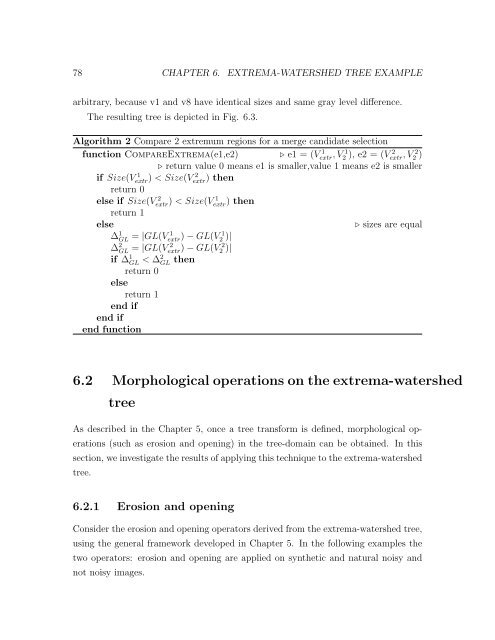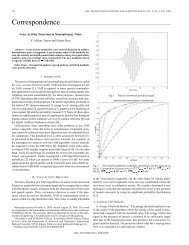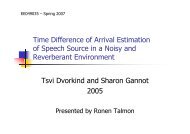Thesis (PDF) - Signal & Image Processing Lab
Thesis (PDF) - Signal & Image Processing Lab
Thesis (PDF) - Signal & Image Processing Lab
Create successful ePaper yourself
Turn your PDF publications into a flip-book with our unique Google optimized e-Paper software.
78 CHAPTER 6. EXTREMA-WATERSHED TREE EXAMPLE<br />
arbitrary, because v1 and v8 have identical sizes and same gray level difference.<br />
The resulting tree is depicted in Fig. 6.3.<br />
Algorithm 2 Compare 2 extremum regions for a merge candidate selection<br />
function CompareExtrema(e1,e2) ⊲ e1 = (V 1<br />
extr, V 1<br />
2 ), e2 = (V 2<br />
extr, V 2<br />
2 )<br />
⊲ return value 0 means e1 is smaller,value 1 means e2 is smaller<br />
if Size(V 1<br />
extr) < Size(V 2<br />
extr) then<br />
return 0<br />
else if Size(V 2<br />
extr) < Size(V 1<br />
extr) then<br />
return 1<br />
else ⊲ sizes are equal<br />
∆1 1<br />
GL = |GL(Vextr) − GL(V 1<br />
2 )|<br />
2 = |GL(V 2 )|<br />
∆2 GL extr) − GL(V 2<br />
if ∆1 GL < ∆2GL then<br />
return 0<br />
else<br />
return 1<br />
end if<br />
end if<br />
end function<br />
6.2 Morphological operations on the extrema-watershed<br />
tree<br />
As described in the Chapter 5, once a tree transform is defined, morphological op-<br />
erations (such as erosion and opening) in the tree-domain can be obtained. In this<br />
section, we investigate the results of applying this technique to the extrema-watershed<br />
tree.<br />
6.2.1 Erosion and opening<br />
Consider the erosion and opening operators derived from the extrema-watershed tree,<br />
using the general framework developed in Chapter 5. In the following examples the<br />
two operators: erosion and opening are applied on synthetic and natural noisy and<br />
not noisy images.
















